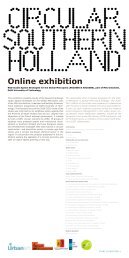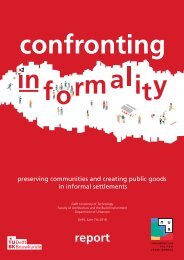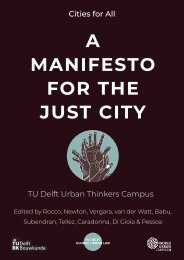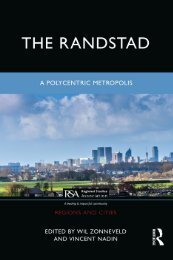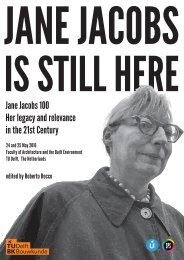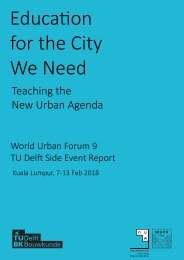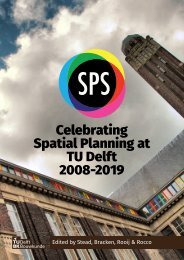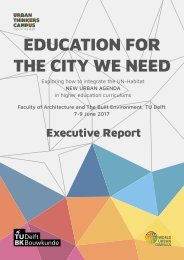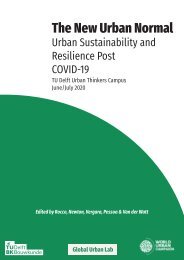The Randstad, a polycentric metropolis, by Vincent Nadin & Will Zonneveld. (Introduction Chapter)
Introduction The Randstad is a cluster of relatively medium-sized and small cities in the western Netherlands that encircles an expanse of largely open land. It is undoubtedly an important urban region, hosting in an area of about 7,000 km2, Europe’s largest seaport, third busiest airport, second largest Internet Exchange, and about 7 million people. But the Randstad is much more than this. Since the 1960s, it has acquired distinction as the archetypal polycentric metropolis, an integrated urban ring around a Green Heart, with the status of a world-class metropolitan region. There is a presumption too, that government has played an inf luential role in strengthening the polycentricity of the region, especially through its renowned capability in spatial planning. But the reality of the polycentric Randstad as opposed to the idea is controversial, as is the role of spatial planning. Do the interconnections between the four main cities – Amsterdam, The Hague, Rotterdam, and Utrecht – and the many smaller settlements in-between function as an integrated polycentric region? Does the economic and social performance of the combined whole of the Randstad add up to more than the sum of its parts? Advocates point to the apparent complementarity of the main cities with a tendency for business and financial functions to be centred in Amsterdam, port and logistics in Rotterdam, governance and international justice in The Hague, and research and development in Utrecht. Critics draw attention to the relatively limited f lows of commuters between the cities, and the concentration of the daily urban f lows within the individual city-regions, which they argue operate independently.
Introduction
The Randstad is a cluster of relatively medium-sized and small cities in the
western Netherlands that encircles an expanse of largely open land. It is undoubtedly
an important urban region, hosting in an area of about 7,000 km2,
Europe’s largest seaport, third busiest airport, second largest Internet Exchange,
and about 7 million people. But the Randstad is much more than
this. Since the 1960s, it has acquired distinction as the archetypal polycentric
metropolis, an integrated urban ring around a Green Heart, with the status of
a world-class metropolitan region. There is a presumption too, that government
has played an inf luential role in strengthening the polycentricity of the
region, especially through its renowned capability in spatial planning.
But the reality of the polycentric Randstad as opposed to the idea is controversial,
as is the role of spatial planning. Do the interconnections between the
four main cities – Amsterdam, The Hague, Rotterdam, and Utrecht – and
the many smaller settlements in-between function as an integrated polycentric
region? Does the economic and social performance of the combined
whole of the Randstad add up to more than the sum of its parts? Advocates
point to the apparent complementarity of the main cities with a tendency for
business and financial functions to be centred in Amsterdam, port and logistics
in Rotterdam, governance and international justice in The Hague, and
research and development in Utrecht. Critics draw attention to the relatively
limited f lows of commuters between the cities, and the concentration of the
daily urban f lows within the individual city-regions, which they argue operate
independently.
You also want an ePaper? Increase the reach of your titles
YUMPU automatically turns print PDFs into web optimized ePapers that Google loves.
Introducing the <strong>Randstad</strong> 7<br />
are a prerequisite for pursuing <strong>polycentric</strong>ity. In Europe, since the 1990s<br />
there has been a proliferation of special planning areas for functional planning<br />
regions, or soft spaces, that cut across formal administrative jurisdictions<br />
(Allmendinger et al., 2015a,b). <strong>The</strong>y operate at different scales for many purposes,<br />
but include many planning initiatives to strengthen the <strong>polycentric</strong><br />
attributes of regions. To some extent they provide a ‘metagovernance’ for the<br />
region that overcomes the limitations of fixed territoriality and creates conditions<br />
for combining different forms and scales of governance arrangements<br />
in smaller units, including their spatial strategy making (Allmendinger and<br />
Haughton, 2009).<br />
Spaans and <strong>Zonneveld</strong> (2015) describe the <strong>Randstad</strong> and the Green Heart<br />
as archetypal ‘soft spaces’ (although from the mid-1990s the boundaries of the<br />
Green Heart were ‘hardened’ through precise mapping in regulation plans).<br />
However, as we explain below, the creation of a governance platform at the<br />
<strong>Randstad</strong> level has eluded its advocates. Nonetheless, there are many other<br />
overlapping and intersecting soft spaces within the western Netherlands,<br />
where governance platforms have been established and are active, including<br />
for the south and north ‘wings’ of the <strong>Randstad</strong> (the regions surrounding<br />
Amsterdam and Rotterdam-<strong>The</strong> Hague), inter-municipal cooperation areas,<br />
and other ad hoc cooperation arrangements. At the <strong>Randstad</strong> level, it has<br />
not been possible to reach political agreement about the validity of the space<br />
and the concept because of the very large number of varied interests and<br />
the attitudes of particularly powerful ones. Bounded spaces for government<br />
are deeply rooted, not least in the Netherlands where the municipalities are<br />
relatively powerful. Local governments can claim legitimacy as the accountable<br />
policy maker when it suits them. But even if there is no platform at the<br />
<strong>Randstad</strong> level, the existence and endorsement of the <strong>Randstad</strong> concept may<br />
still play a role in reminding the actors that they are playing on a wider stage<br />
than their immediate surroundings.<br />
At the wing level and other sub-spaces within the <strong>Randstad</strong>, cooperation<br />
has proved more workable though still difficult, and a layering of nested planning<br />
spaces has emerged with a mix of formal and informal institutions formulating<br />
shared policy through varying processes and levels of competence.<br />
At this level, cooperation tends to be associated with plainly strong functional<br />
relationships with obvious flows of commuters and tangible and intangible<br />
goods and services crossing between the constituent jurisdictions. However,<br />
the many cooperation arrangements across the <strong>Randstad</strong> tend to be in the<br />
form of networks, with government in control often aligned with business<br />
and its agenda over a specified territory, rather than the more fluid bottom-up<br />
actor networks that have been advocated (Jauhiainen and Moilanen, 2011).<br />
<strong>The</strong> lack of deeper cooperation arrangements at the <strong>Randstad</strong> scale reflects<br />
much uncertainty about whether it actually constitutes a functional<br />
region, and if the pursuit of <strong>polycentric</strong>ity would bring the benefits claimed.<br />
<strong>The</strong> chapters that follow address these issues thoroughly. Here, we should<br />
emphasise that there is very diverse mix of attitudes to the <strong>Randstad</strong>. <strong>The</strong>re<br />
Taylor & Francis




